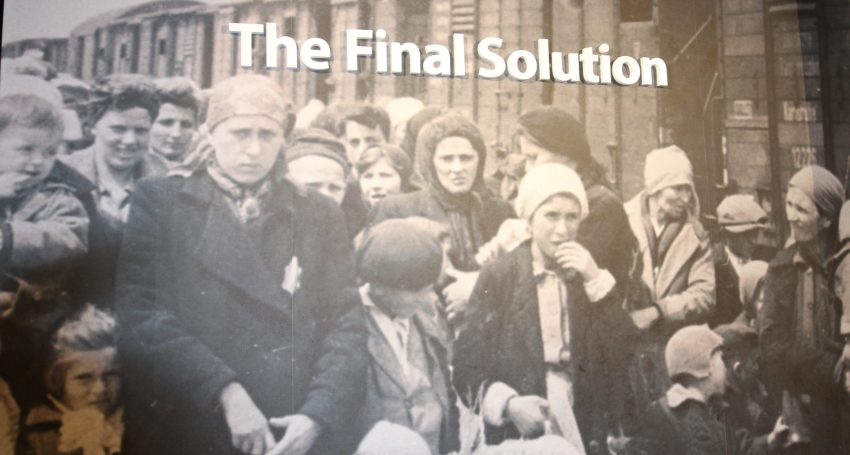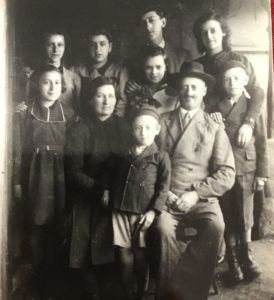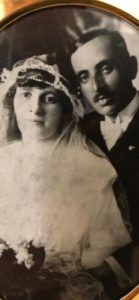Visiting Auschwitz - a very personal perspective
Opinion
Some six months after his visit to Auschwitz in 2006, Dr Ron Hoenig told how he still felt “invaded” by the experience.

Driving into Krakow from the airport, our taxi driver asks, “How long are you staying? Two weeks?” No, two days, I reply a bit guiltily. After all, there’s more to see in Krakow than Auschwitz, which is about an hour’s drive away. Yet these days, many – most? – people come to Krakow, like us, to dip their toes in its tragic Jewish past.
We stay in the Wyspianksi Hotel. It’s a 40-year old Soviet era hotel that has recently been “completely refurbished” with the charm and the awkwardness of the new Eastern Europe. There is rich honey wood paneling around beds and fittings and a huge and imposing clothes hanging area and a light and airy bathroom, but the sliding door to the shower is too light. Flimsy.
Advertisement
The dining room is quite sumptuous. We share it with a large group of French tourists. Jews? Perhaps. We see some of them the next day at Auschwitz.
I don’t sleep well the night before. The time we had agreed to meet the guide is now confused in my head. Was it 7:30 or 9:00 in the morning?
I feel the creeping anxiety and excitement. “Why do you want to see Auschwitz,” a character in a play I once wrote asks, “You sleep too good?” I keep replaying a joke in my head: What’s fastest thing on two wheels? A Jew going through Germany on a bike. But really the central horror was Auschwitz.
In the morning, we breakfast early. Just in case. We walk out of the hotel restaurant and we see a slim straightbacked distinguished looking gentleman in his late 50s in a formal blue suit. “Pan Hoenig?” he enquires. “I am your driver.” The car is a late model Renault hatchback fitted out for wealthy tourists. Marion and I are soon on our way out of Krakow. But there is a thick fog and as we drive past some of the most notable buildings in Krakow, they lurk , much to the frustration of our driver, anonymously in a grey impenetrable haze.
Why am I doing do this? Is it a pilgrimage? Ghoulish tourism? And what if Auschwitz turns out to disappoint in some way? What if visiting the “museum” is not horrible enough and I can’t suppress my critical faculties and dismiss some of the experience as Holocaust “lite”, not the “real” thing?

Gizi and her family before the Second World War
What, after all, is there to see that I have not already seen in pictures and films?
There is no way to retrieve the life of so many of my family who were murdered there.
I remember the first time my mother used that word “murdered” in this context. My daughter, Sara, was perhaps 12 years old when she asked Mum about Mum’s parents. My mother said simply, but bitterly, that they had been murdered during the war. The word I would have normally used was “killed”. As in a car accident.
Advertisement
I remember Sunday afternoons in my childhood when my parents’ Hungarian friends – all Holocaust survivors – would sit and devour poppyseed or rolled chocolate or walnut beigli or yeast cake and talk about their past. They spoke Hungarian but they mixed in the words the Nazis used: KaZett (KZ) from “KonZentrazionslager” or concentration camp. (Like all bureaucrats, the Nazis liked acronyms and initials); lager or “camp” and, in Hungarian translation “likvidáltak öket” or “they liquidated them” – as in a business, or assets, or trainloads of Jews.
Perhaps “murdered” was a bit harsh for my early teenage daughter to hear from her loving but occasionally prickly grandmother. But it was true.
Both sets of my grandparents and half my mother’s immediate family, my young never-to-be uncles and aunts, not mention scores of more distant relatives were murdered there in the last few months of the war, when the Hungarian Jews experienced the most efficient and industrialized slaughter the doomed Third Reich could devise.
So what sense is there in visiting the scene of this crime? And how will I feel about the Poles who would lead me through it?
I have searched hard on the Internet to find a Jewish guide and I have come up with the Jarden tour company which runs the only Jewish bookshop in Poland. But, as their email tells me, although their guides speak excellent English and have been trained at Yad Vashem, they are, nevertheless, not Jewish.
What do we think we will gain from a private tour through hell? What fear or private arrogance lies behind our decision to want to be individually guided rather than herded as part of one of the many tourist groups that do Auschwitz in their Polish tours.
It’s nine o’clock when we arrive. It’s sunny and the fog outside has cleared, but not in my head. Our driver hands us over to our guide. She is fortyish, speaks excellent English and is very efficient. She begins to tell us the story of the construction of the main camp, originally as a place for political prisoners. She has had lots of practice, but it is an effort of memory. Sometimes, throughout the tour, I watch her eyelids close and the lids flutter as she reaches back into her memory and into her store of English for a telling fact or a complex number.
The original town of Ozwiecim was destroyed and the bricks used in the building of Auschwitz I. It’s yet another ironic reminder of the abstemious and ecologically correct nature of the Nazis. Nothing was wasted. Later I find out that this part of the story is not just history to our guide. She lives in Ozwiecim.
What sort of an address is Auschwitz?
Ironies fall over themselves. The tourist buses that cluster in the carpark at Auschwitz come from Krakow along the same beautiful tree-lined road as we did. They deposit tourists, who commune with their souls for a few brief hours, and then they drive back to Krakow. Many of them, like us, later filter into the old Jewish part of Krakow that enlightened king Kazimierz established by in medieval times for the Jews outside the walled city and named for himself. And later, like us, the tourists eat “Jewish” specialties in restaurants run by new post-Communist Polish entrepreneurs, who are not Jews. There are very few Jews living in Krakow.
And if the people of Krakow resent the fact that the western tourists come to Krakow not to enjoy the architectural and historical delights of the beautiful city, the heart of the Polish enlightenment, but mainly to visit this museum, then think of the people of Ozwiecim, who live next to this tourist mecca, this blot on the history of humanity and do not experience the full benefits of this tourism, and resent it.
As our guide begins her spiel, we walk towards the gate. It suddenly occurs to me that we are actually walking towards the infamous gate with its ironic invocation Arbeit Macht Frei and I feel that I want to cut the flow of words. I tell her about my family. She nods but does not take it in. I feel an obligation to take pictures, and I do here, but as the tour progresses and the guide takes us deeper into Auschwitz, I feel more constrained about taking photos.
Auschwitz I is made of x number of two-story barrack like buildings set in rigid lines. The grass between them is well-tended and green.
We walk upstairs in the main barracks and enter a long corridor. The display rooms open off here. We walk into a long room. To our left, the length of the room, perhaps two meters deep, is glassed in. Behind the glass is what seems like a mountain of human hair. Some of it is packed in the bales the Russian troops discovered when they liberated Auschwitz in 1945. But much of it is unpacked, dusty and lifeless, ghostly and greyed by time. Some of it is unrecognizable as human; some is in plaits and braids. I am struck dumb and gasp for breath. Our guide gives me a little time.

Ron’s grandparents on his father’s side who were murdered in Auschwitz
Behind us, on the back wall is the hair woven into a roll of brown fabric. German military tailors used it to stiffen collars, she tells us.
In another room there are what seems like thousands of shoes, dusty, crumpled and unlaced, thrown into piles. And another room of luggage and another of prosthetic limbs and another of children’s clothing.
We pass the wall where the shootings of prisoners took place when Auschwitz was only a prison camp and not a death factory, before a more efficient means of liquidating masses of Jews became necessary.
Then we are led down to the one remaining oven where bodies were turned into ash.
This slaughterhouse seems now a sacred place. In here, I don’t want to look into a viewfinder. To retreat to that level of distance from the horror of what went on here feels too sacrilegious. I take a few images, holding the camera away from me and clicking the button. What does it matter how good the photos are anyway?
Our guide leads us into a small room. Out of the murk I see a class of teenage Israeli students. They have been with us occasionally in the middle distance, t-shirted and sneakered, equipped with ipods and digital cameras. Now the kids sit in this place of sanctuary and rest and then one by one they light a mourning candle and read out the name of a dead person. I think the mourning is for a family member, but it may not have be. The kids weep gently and comfort each other. Marion and I sit in the dim light of a square of many candles and mourn with them.
We complete our tour of Auschwitz 1 and we are about to be driven a very short way to Birkenau. “But perhaps you would like to go the toilet and have something to eat,” our guide says. “I will meet you in 20 minutes.”
After all, Auschwitz is a tourist attraction. Delivered to the visitor’s centre, you pay for tickets, you go to the toilet, you drink coffee or soft drink. And at the same time as I hand over money to people behind the counter, my mind struggles to come to terms with the irony of who I am and the accident of my presence in this place. Free, able to walk in and out unfettered. A tourist. The use of the toilets is not constrained by time and space. In my hand is a camera. In my pockets there is Polish money. And around me, there are signs that consign the darkest uses of this place to history, to a time before I was born.
We drive to Birkenau and, as the tour goes on, and we walk past the ruins of the gas chambers and crematoria which remain now in the same bombed out state that the Soviet troops found them in May 1945, our guide, a professional conservator, details the efforts to which the Polish authorities have gone to keep the ruined bricks in place and the collapsed roof in the same state as they were at the moment of liberation in January 1945. The task is a monument to the meticulous and perhaps ultimately quixotic attempt to preserve things as they were. Water, soil movement and the work of time will slowly erode the best efforts of humans to freeze time.
At the western end of Birkenau there is an International Monument, erected in 1967 to the victims who died in the Auschwitz II camp. It lies at the end of the main camp road between the two barbed-wire enclosures around the ruins of the two crematoria, where the largest gas chambers were located.
The railroad tracks brought my families here some time in May or June 1944, where the trains disgorged thousands of people at a time to be sorted into those for immediate destruction and those for whom it should take a little longer.
About 20 years ago, I came across photographs of Hungarian Jews from Carpatho-Ruthenia arriving at the selection place, where I am now standing. I suddenly realized then that I was staring at a photograph in which, unknown to me, unrecognized, my grandfathers or grandmothers, uncles or aunts might be in the crowd in their last few hours before their murder.
There are square black granite plaques in 20 European languages, including English and Hebrew, all have the same text in memory of the Jews of those countries who were murdered here. In English, it says:
“May this place where the Nazis assassinated a million and a half men, women and children, a majority of them Jews from diverse European countries, be forever for mankind a cry of despair and of warning.”
Unwilling martyrs, their horrible death cries out for some sort of redemption, but that redemption can only come from those of us who, by some strokes of luck outlived them.
This trip is, I suppose, an attempt to pay respect, to celebrate their un-graved memory. But, of course, as in all things to do with death, it is an event for the living, a one-way conversation between me and my unknown but (somehow) present ancestors.
Related Story
Gizi's story a flicker of light in the darkness
I take a photo of the Hungarian plaque. It is a gravestone of my family. In Hungarian the word for grave, sír, pronounced “sheer” is the same as the word for “to cry”. A gravestone is a sírkő – a crying stone.
What I did not know was that these photos are among a select set of photographs taken by an SS photographer to record for the achievement of the big annihilation of Hungarian Jews. There were 400 000 murdered here between May and December 1944. There are very few photographs taken of the arrival of Jews at Auschwitz and these are the ones remaining, until the Soviet troops took their movie images of the rescue of the survivors in 1945.
And after the long tour that took us from Auschwitz to Birkenau about two kilometres away, which was specially built for the purpose of slaughtering Jews, and now stunned by the multiplying ironies and mute horrors we had been through, our guide suggested we might like to buy a postcard and pointed to one of the photographs from the very same set of images. I explained to the guide despairingly because I had done it once before that these were not the photographs that I wanted as a keepsake.
Instead we bought a DVD of the liberation filmed by a Russian camera man. A few weeks ago I finally screwed up the courage to watch it. It’s mostly silent. I sat cross-legged on our living room floor and watched it. I wish I could say I wept, but I sat stone faced. And then slowly moved on with my day.









Comments
Show comments Hide comments